 |
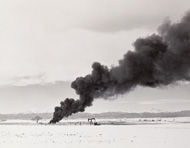
 |
 |
Burning Oil Sludge North of Denver, Colorado, 1973
© Robert Adams
|
 |
 |
|
 |
|
For more than 40 years, Robert Adams (born 1937) has photographed the landscape of the American West, particularly in California, Oregon, and his home state of Colorado. His work is inspired both by his joy in the inherent beauty of the landscape, and his dismay at its exploitation and degradation for residential and commercial development.
In his images of main streets, tract houses, trees, and waterways, Adams records two kinds of landscapes, one damaged by people and the other somehow beyond their power to harm. He asks us, through his photographs, to consider where we live and how we relate to our environment. In the image above, the noxious black cloud provides an unexpected beauty against the snow-covered Colorado Rockies. This photograph exemplifies Adams' vision: the simultaneous existence of harmony and discord, of beauty in ugliness.
|
 |
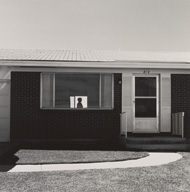
 |
 |
Colorado Springs, Colorado, 1968–1970
© Robert Adams
|
 |
 |
|
|
 |
Adams explored new housing tracts that were being built along the Colorado Front Range in the late 1960s and early 1970s. The developments filled with people who had migrated west in search of a new Eden, only to discover themselves isolated in an artificial landscape. "People had moved [to Denver] to enjoy nature, but found that nature was mostly inaccessible except on weekends," Adams wrote.
Certain elements of this new landscape recur in Adams' photographs: the uniform, boxy houses, concrete, cars, and dirt plots, as well as the loneliness and isolation that attend rapid suburban growth.
|
 |
 |

 |
 |
Colfax Avenue, Lakewood, Colorado, 1970
© Robert Adams
|
 |
 |
|
About his 1970s work, published under the title The New West, Adams wrote, "The subject of these pictures is...the source of all Form, light." He asserted, "I love the light," underscoring that the deeper subject of these pictures is not the tract homes or freeways they depict.
This picture of Colfax Avenue in a suburb of Denver is testimony to both the brutal dominance of the automobile and the imperishable beauty of light.
|
 |
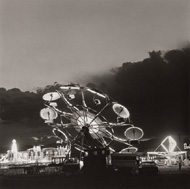
 |
 |
Longmont, Colorado, 1979
© Robert Adams
|
 |
 |
For about five years, beginning in 1974, Adams embarked on an experiment: he made a series of photographs at night—the opposite of the high-altitude daylight used in most of his previous photographs. The project brought an element of risk he had not experienced before. Passing motorists sometimes veered toward him on rural roadsides, and in urban centers police repeatedly questioned him about his activities.
In this photograph, Adams isolates the ferris wheel lights against a threatening sky to create a scene both delightful and ominous.
|
 |
 |
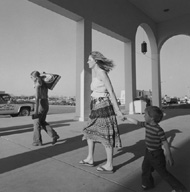
 |
 |
West Edge of Denver, Colorado, about 1980
© Robert Adams
|
 |
 |
|
Adams made a series of photographs focusing on the people who lived near the Rocky Flats nuclear weapons plant outside Denver. The facility processed plutonium, one of the most toxic known elements. Plutonium ignites spontaneously in contact with moist air and caused many fires at the plant, threatening all those living in the area.
Working in shopping center parking lots, Adams abandoned his tripod and learned the strategies of a street photographer. He strapped a camera to his wrist and concealed it behind a grocery bag to make pictures without his subjects' awareness. The photographs reveal in the faces of children, parents, and grandparents a continuity of caring and hope.
|
 |

 |
 |
Ontario, California, 1983
© Robert Adams
|
 |
 |
|
|
 |
While living in Los Angeles in the late 1950s and early 1960s, Adams observed in the surrounding landscape the remains of once glorious citrus estates, transformed after World War II by real-estate developers intent on profiting from the sale of homes to veterans. Adams returned to photograph these changes numerous times between 1978 and 1983.
About the series, called Los Angeles Spring, Adams wrote: "The pictures reveal a persistent verdancy that is unexpected. How could anyone explain the bird in the defoliated orchard, the suddenly clear day on a quiet road, or the astonishing silhouette of a eucalyptus in smog?"
|
 |
 |
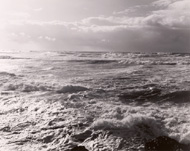
 |
 |
Southwest from the South Jetty at the Mouth of the Columbia River, Oregon, 1991
© Robert Adams
|
 |
The loveliness in this image of sunlight on the moving surface of the Pacific Ocean suggests questions of mortality and immortality and the power of nature. After learning the title, we are reminded that facing the ocean is the landscape of the Northwest coast, an area known for damaged old-growth forests.
"We travel now to beaches in Oregon and Washington in order to face away from the deforested interior," Adams wrote. "Of all the sacred places on the coast, none is more comforting than where rivers join the sea. By the river's disappearance we are reminded of life's passing, while by the ocean's beauty we accept it, in a hope we cannot explain."
The exhibition is located at the Getty Center, Museum, West Pavilion.
|
 |







